Lupine seeds are rich in protein and can therefore serve as a domestic alternative to soy. Here you can find out everything you need to know about lupine seeds.
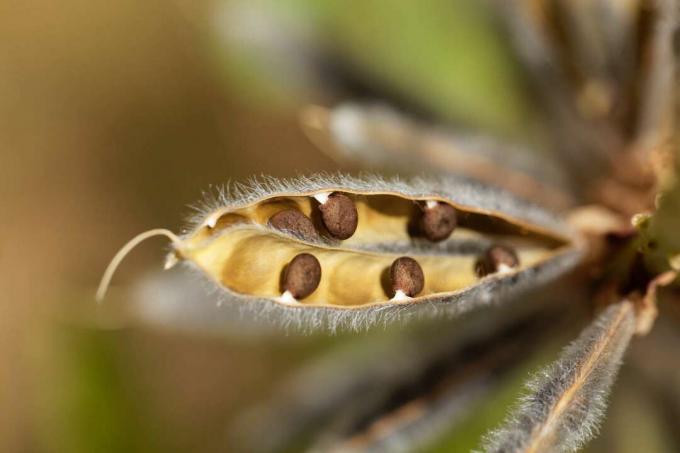
Lupins (Lupinus) thrive wonderfully in our latitudes. Therefore, the protein-rich legumes (Fabaceae) can also be grown in the home garden, where they delight with their colorful flowers and whip up the soil in the process. If you pay attention to the right varieties when planting, nothing stands in the way of your own harvest of the superfood.
contents
-
Lupins: characteristics, claims and origin
- Lupins: Related to peas, beans & Co.
- Lupins as green manure
- Lupins: claims in the garden
-
Lupine seeds: the energy bomb from the garden
- Caution: only eat the seeds of the sweet lupins
-
Harvesting lupine seeds in the garden
- When are lupine seeds ripe?
- How are lupine seeds harvested
-
Using lupine seeds: what can be made of lupine seeds?
- Use lupine seeds for propagation
- Process lupine seeds further
Lupins: characteristics, claims and origin
The protein bombs originally come from North America. Only in the 19th In the 19th century, the lupine was brought to Europe. Due to their undemanding nature, their rapid growth and the high potential of self-sowing, belong the colorful plants are the invasive species that quickly displace native species and are now also indigenous here are valid. Lupins are an effective green manure, a domestic alternative to soy as fodder and can be processed into a variety of protein-rich and healthy foods in the form of their seeds. But it's not just the protein that makes the seeds interesting. The plant is also rich in antioxidants and has an antimicrobial effect.
Lupins: Related to peas, beans & Co.
Lupins, like peas, beans or peanuts, belong to the legumes (Fabaceae also Leguminosae). All legumes, like lupins, have two properties that make them very interesting as a useful plant. On the one hand, the plants of this family are able to enter into symbioses between their roots and bacteria, which optimize the supply of nutrients. On the other hand, the seeds have a high protein content. Unfortunately, many people are allergic to legumes. Lupins are one of the 1 main allergens. The allergies are triggered by certain proteins that are falsely labeled as dangerous by the human immune system. As a result, immune reactions occur which, in the worst case scenario, can lead to anaphylactic shock and even death. How such food allergies develop has not yet been scientifically elucidated. What is certain, however, is that if you have allergies to other legumes, you must be careful when consuming lupins for the first time. Because so-called cross allergies often occur.

Lupins as green manure
Lupins are ideal as green manure in agriculture or in your own bed. During the growth phase, the plants store huge amounts of nitrogen. For this purpose, the plants enter into symbioses with nodule bacteria (rhizobia). The bacteria colonize the roots, bind atmospheric nitrogen and pass it on to the plant in a form that can utilize the green. If the lupins rot, these bound nutrients are released back into the earth and are available for the next plants to take root on the spot. Proceed as follows for a green manure:
- May: sow annual lupins in the area to be improved
- After winter: mowing the lupins
- Leave the cut as a layer of mulch
- Let the layer dry and then work it into the floor
- After four weeks, new plants can be sown / planted
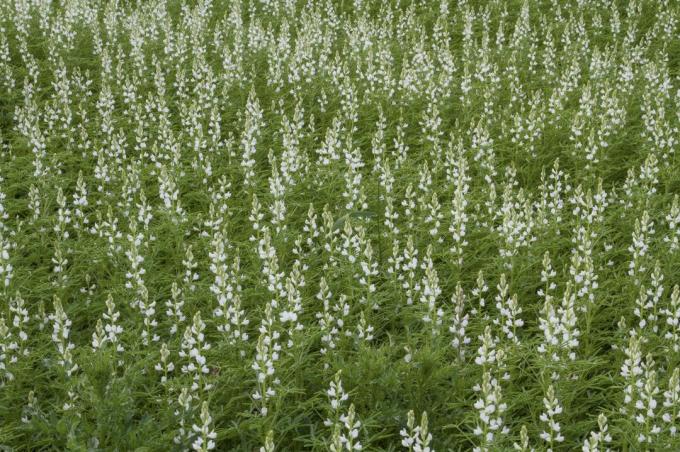
But lupins don't just pass on nutrients. Their strong roots reach very deep and loosen the soil.
Lupins: claims in the garden
Lupins don't have many demands on the place they grow. Only a little sun is needed for the lupins to bloom long and iridescent. The soil is loosened by its strong roots, but should not be too calcareous. Subsequent care is also not a big act, because the deep roots and the symbiosis with nodule bacteria ensure excellent self-sufficiency. Anyone wondering about the Growing lupins in your own garden want to provide more detailed information, you will find everything that the inquisitive hobby gardener might be interested in here.

Lupine seeds: the energy bomb from the garden
Lupine seeds have a protein content of up to 40% and are increasingly considered the Nordic alternative to imported soy. However, lupine products are more expensive than the soy variants. There is a great temptation to simply harvest the seeds yourself. However, great caution is advised when consuming unchecked lupine seeds.
Caution: only eat the seeds of the sweet lupins
Originally, lupins have a very high content of bitter substances. These chemical compounds, in this case mainly lupnine and sparteine, are poisonous to humans and most animals. So don't get the idea of simply harvesting lupins that you have discovered in meadows and eating them without any pretreatment. The lupine seeds, which serve as the basis for food, belong to a special breed, the sweet lupins. These contain no or almost no bitter substances and can be processed further without hesitation. You can find out more about differentiating between lupine species as well as possible signs of poisoning and what to do in an emergency in our article: "Lupins: caution poisonous“.
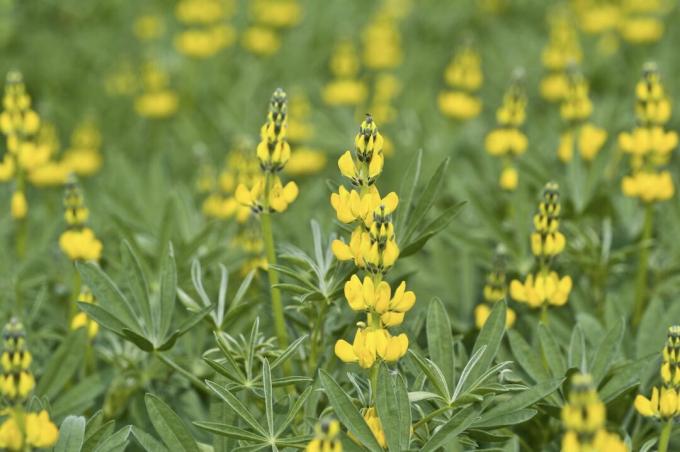
Harvesting lupine seeds in the garden
Lupins form vast amounts of seeds with which they can spread in the garden - usually faster than you would like. If you don't want to harvest seeds and want to prevent them from spreading, simply cut off the faded inflorescences. However, if you want to harvest the seeds for propagation or consumption, the inflorescences are left on the stems. The pods, in which the coveted seeds are located, are later formed from them.
When are lupine seeds ripe?
The degree of ripeness of the seeds is revealed by the appearance of the pods. The seeds are ripe when the pod is dry and dark. This is usually the case in late summer.
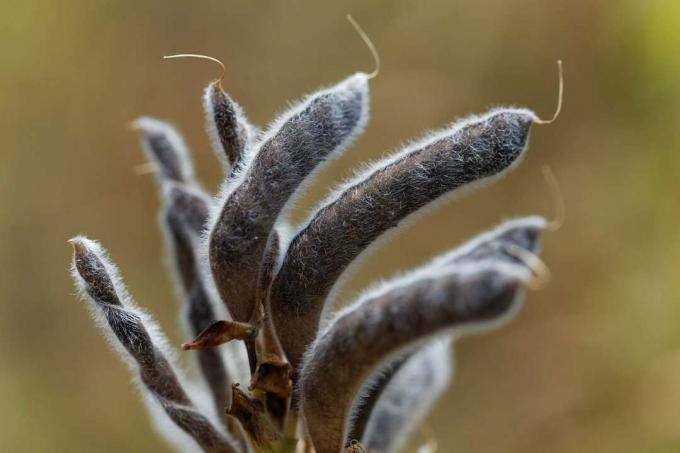
How are lupine seeds harvested
Once you have harvested ripe pods, the harvest is complete in next to no time. The seeds can then be easily pressed out of the pod. The dark seeds are then cleaned with water and dried.
Using lupine seeds: what can be made of lupine seeds?
Lupine seeds can be used in a wide variety of ways. On the one hand, they serve to propagate the plants. On the other hand, the protein-rich seeds can be processed into healthy foods that are free from animal components.
Use lupine seeds for propagation
Dried seeds can still germinate after three years if they have been stored airtight and in the dark. The seeds are sown directly in the bed, but can also be grown inside in the pot. Proceed as follows:
- Sowing time: March - May [pot: January]
- Lightly roughen the seeds with sandpaper
- Let the seeds soak in water for 24 hours
- Sowing depth: 2 to 3 centimeters
Lupins grown in pots are planted in the bed from June. Perennial lupins can even be sown in the bed well into August.
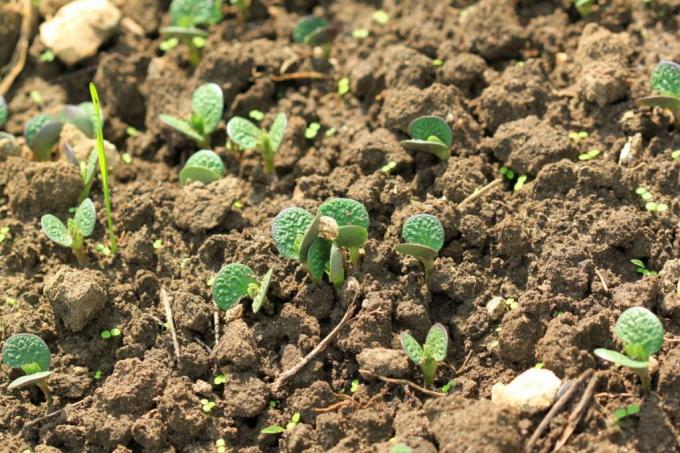
Process lupine seeds further
The product range for lupins is increasing rapidly, because more and more people eat consciously and are immensely important. The number of vegetarians and vegans is increasing every year and the market naturally reacts to the increasing sales opportunities. Unfortunately, soy does not thrive here and has to be imported with high emissions. Lupins, however, can be grown regionally and are therefore even suitable for self-catering. Those who harvest themselves or buy lupine seeds in stores have many options for further processing the seeds. However, there are lupins to buy in the processed form. Here is a selection of delicious ones Food made from lupine seeds - from ice cream to coffee.

